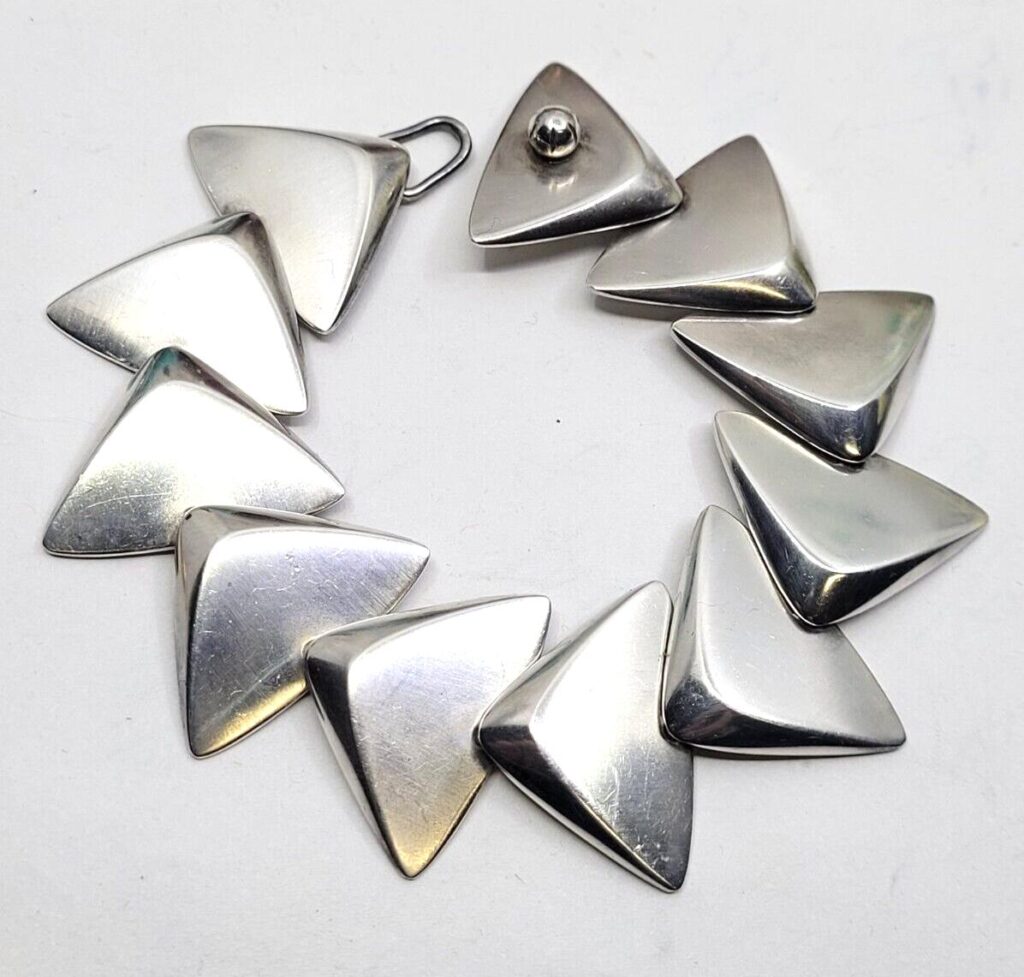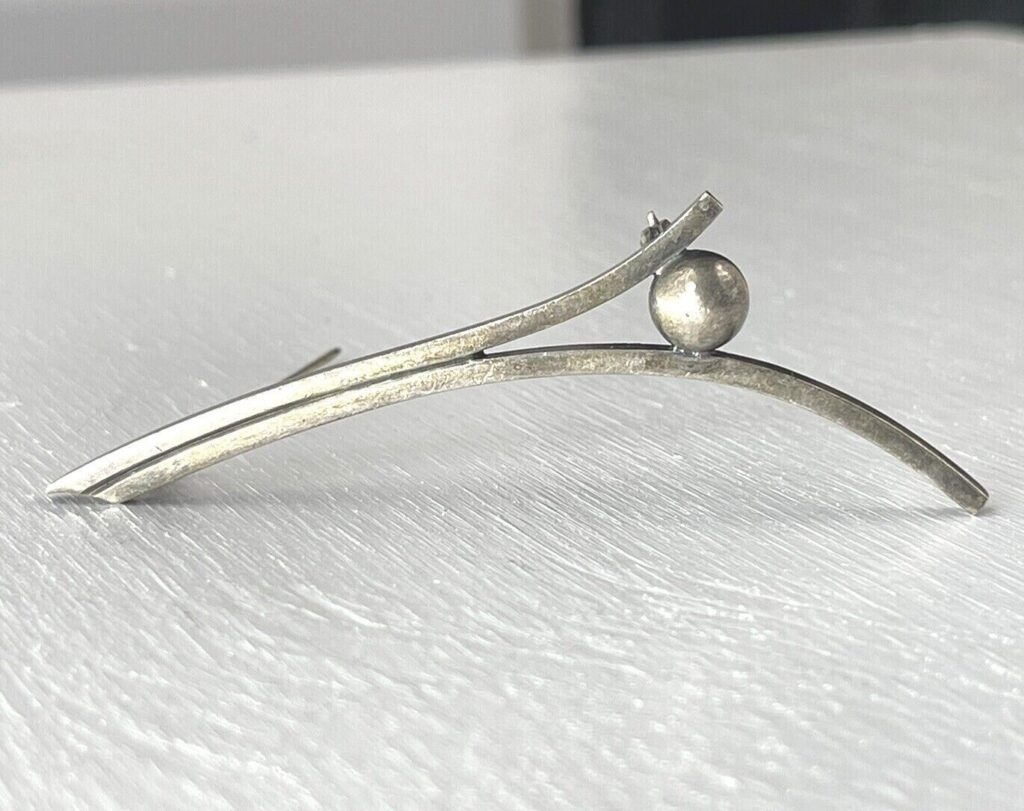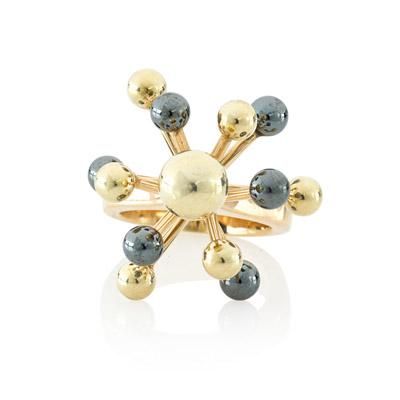#Identify #Hans #Hansen #Jewelry #WorthPoint
The world of modernist jewelry design can be a fascinating field of study, whether you’re building a collection or researching a thrift store find. Danish metalsmiths led the way in popularizing this type of jewelry as early as the 1930s. Hans Hansen is credited for pioneering the movement that eventually spread across Scandinavia and the world.
The Hans Hansen workshop thrived for many decades through family ownership and the contributions of several well-known Danish craftsmen. Some of the designs that came out of this business are remarkably futuristic, which can be quite valuable; others are rather mundane and worth far less.
Beginning with some background on the business is a good place to start when learning about jewelry marked Hans Hansen.
More on the Hans Hansen Workshop
Located in Kolding, Denmark, Hans Hansen founded his namesake gold and silversmithing workshop in 1906. The primary focus of the business was hollowware and flatware in the beginning. Jewelry took a more prominent role in the shop when his son, Karl Gustav Hansen, moved from apprenticing to working as a designer in 1932.
Karl Gustav Hansen’s designs for a line called “Future” were completely different from other sterling silver jewelry pieces crafted in Denmark at the time. In fact, they were given the somewhat pejorative nickname “Funkis,” which referenced the funky functionalism of the pieces. Nevertheless, the jewelry was well-received by consumers and sold readily into the 1940s.
When his father suddenly died in 1940, Karl Gustav Hansen took over the workshop at the age of twenty-five. He focused mainly on the hollowware side of the business moving into the 1950s and left jewelry design to others. This who’s-who list of Hansen’s modernist designers includes Bent Gabrielsen (also known as Bent Gabrielsen Pedersen), who worked in the shop from 1953 to 1969 and began directing jewelry design for Hans Hansen in 1962. Karl Gustav Hansen resumed jewelry design after Gabrielsen left and continued his work there until he died in 2002.

Other silversmiths employed by the Hans Hansen workshop over time include Bent Knudsen, Eigil Jensen, and Allan Scharff. Jensen left to join A. Michelsen, another prominent silversmithing shop in Denmark, and Scharff went to work for the renowned Georg Jensen workshop. One of Scharff’s well-known Georg Jensen designs called “Alliance” was designed while he was still working for Hans Hansen.
In 1991, Hans Hansen was taken over by Royal Scandinavia Group (Royal Copenhagen), which also acquired Georg Jensen. After the companies merged, some Hans Hansen designs were moved into Georg Jensen’s design catalog.
Identifying Hans Hansen Jewelry
The primary mark used to identify jewelry made in this Danish workshop is “Hans Hansen” in script lettering, but “HaH” was also used in many designs. Unlike the work of some other jewelry businesses, Hans Hansen designs cannot be dated using marks because the same stampings were employed over many decades. However, when you see both George Jensen and HaH marks on a piece of jewelry, that can indicate the item was produced after the 1991 move of both brands under the Royal Scandinavia umbrella.
Most jewelry designs made in the Hans Hansen workshop were modernist in style, including the early “Future” pieces designed by Karl Gustav Hansen. The line included fifty different earring, ring, and brooch designs. While those have only sterling silver elements, other Hans Hansen ring and brooch styles are embellished with stones, including tiger’s eye, lapis, and amethyst, among other lesser-value gemstones.
This workshop also produced many modern necklace styles, including wire collars with pendants and the popular “Peak” design with matching bracelet. Other bracelets are more traditionally styled, such as large link chains with toggle clasps. Many different cufflink styles for men were also produced with the Hans Hansen stampings to identify them.
Values for Hans Hansen Jewelry
Not surprisingly, many of the highly valued Hans Hansen pieces are made of 14-karat gold. These can easily sell in the thousands, whether they’re bracelets, necklaces, or kinetic ring designs. However, the number of sterling silver pieces produced far outweighs those crafted of gold.
Silver jewelry originating in the Hans Hansen workshop runs the gamut in price. On the higher end, keep an eye out for Hans Hensen designs with extraordinary flair, including complex designs and those with movable elements.
Many necklace and bracelet styles can indeed sell for more than $1,000, especially if they are associated with a recognized modernist designer like Gabrielsen or Scharff. It’s not always possible to research the designer of a piece of Hans Hansen jewelry, but adding that information to an online listing when it’s available can boost the price.

Some of the co-branded George Jensen/Hans Hansen pieces also bring sums moving from the high hundreds into the thousands. Amazingly, you can sometimes score the original “Future” designs by Karl Gustav Hansen that started the modernist jewelry movement for several hundred or less.
As you’ll notice when perusing the WorthPoint Price Guide, not all silver jewelry with a Hans Hansen mark will bring prices higher than $100. There are many, many pairs of simple earrings and small brooches in boomerang and heart shapes, along with others that can sell for $50 or less on their own. It’s perfectly fine to pick those up; just be sure not to overpay. Also, remember that when those plainer pieces are parts of complete jewelry suites, the price can rise dramatically into the hundreds.
Now you know more about the Hans Hansen workshop and its important place in modernist jewelry history. You’ll also be better equipped to know which jewelry to purchase and how much to pay, whether you’re buying for yourself or for resale.
Pamela Siegel is a freelance writer and author who has been educating collectors for more than two decades. In addition to three books on topics relating to antiques and collectibles, she frequently shares her expertise through online writing and articles for print-based publications. Pamela is also the co-founder of Costume Jewelry Collectors Int’l (CJCI) and the proprietor of Chic Antiques by Pamela.
WorthPoint—Discover. Value. Preserve.




